Let's Play Monsterball!
Welcome to Monsterball! Monsterball is an exciting all-ages collectable card game of skill and luck that will feel both terrifyingly new and unsettlingly familiar. Getting started is as easy as picking up a premade team deck that will have everything you need to start playing right away. Premade monsterball team decks will be available on Kickstarter starting on October 1, 2025!
As the manager of a monsterball team, you will use your skills as a manager and direct the skills of your players to win against other monsterball teams. You can even customize your team and playbook, collecting and trading players and plays to build an unstoppable monsterball machine.
Once you’ve got your feet wet, customize your team and playbook with cards from boosterpacks. You never know what you’ll find in a Monsterball boosterpack, but starting up a collection and making trades with your friends is all part of the action and fun. And of course, you can always pick up new cards at MonsterballCCG.com
Card Types
Before we get into the gameplay, let’s start by learning about the different types of monsterball cards. There are 2 main card types that you will work with as a manager - player cards and playbook cards. Both of these cards are crucial to fielding a winning team.
Player cards have two sides. The front of each player card lists the player’s stats and abilities. The back of each player card features full-card artwork depicting the player.
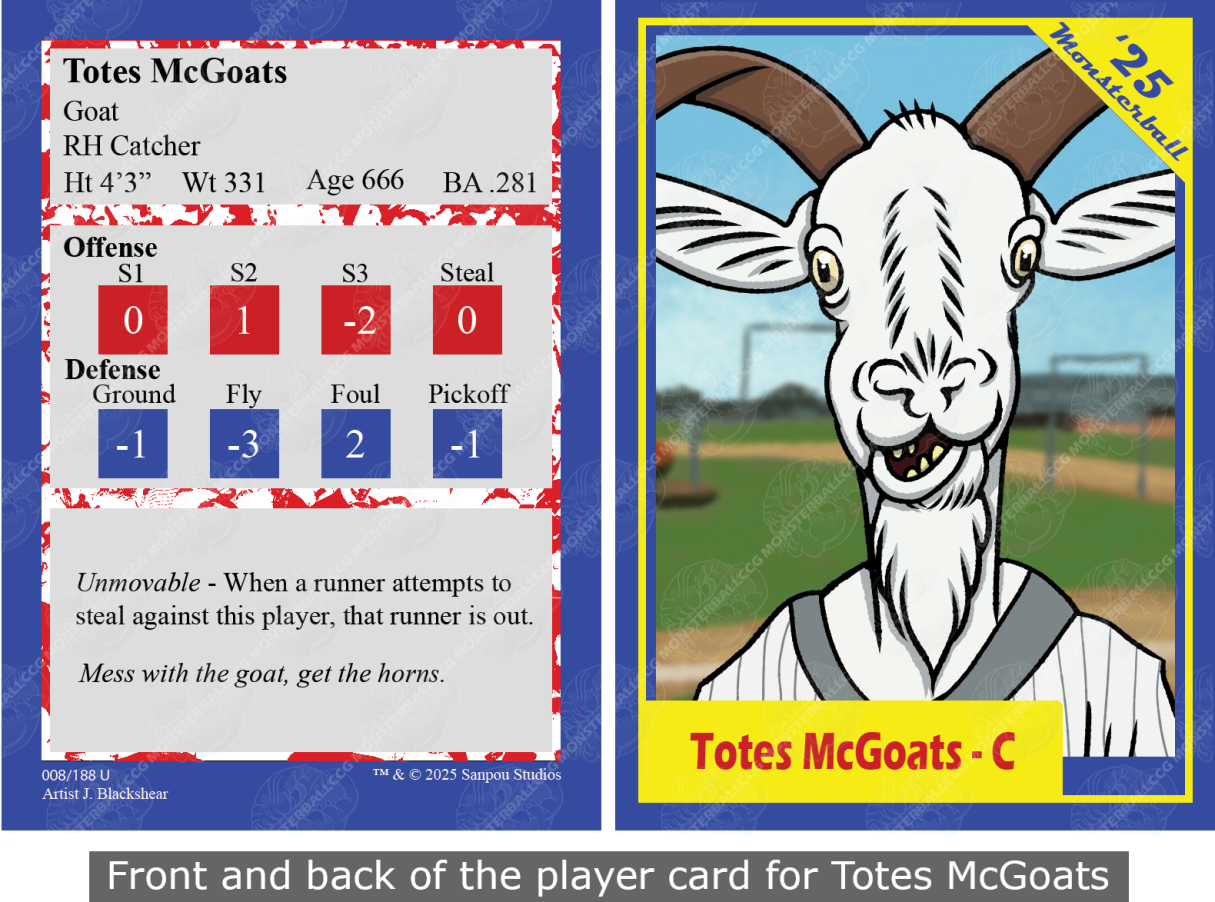
Playbook cards have the artwork and mechanics of the card on the front of each card. The back of each playbook card features the Monsterball logo.
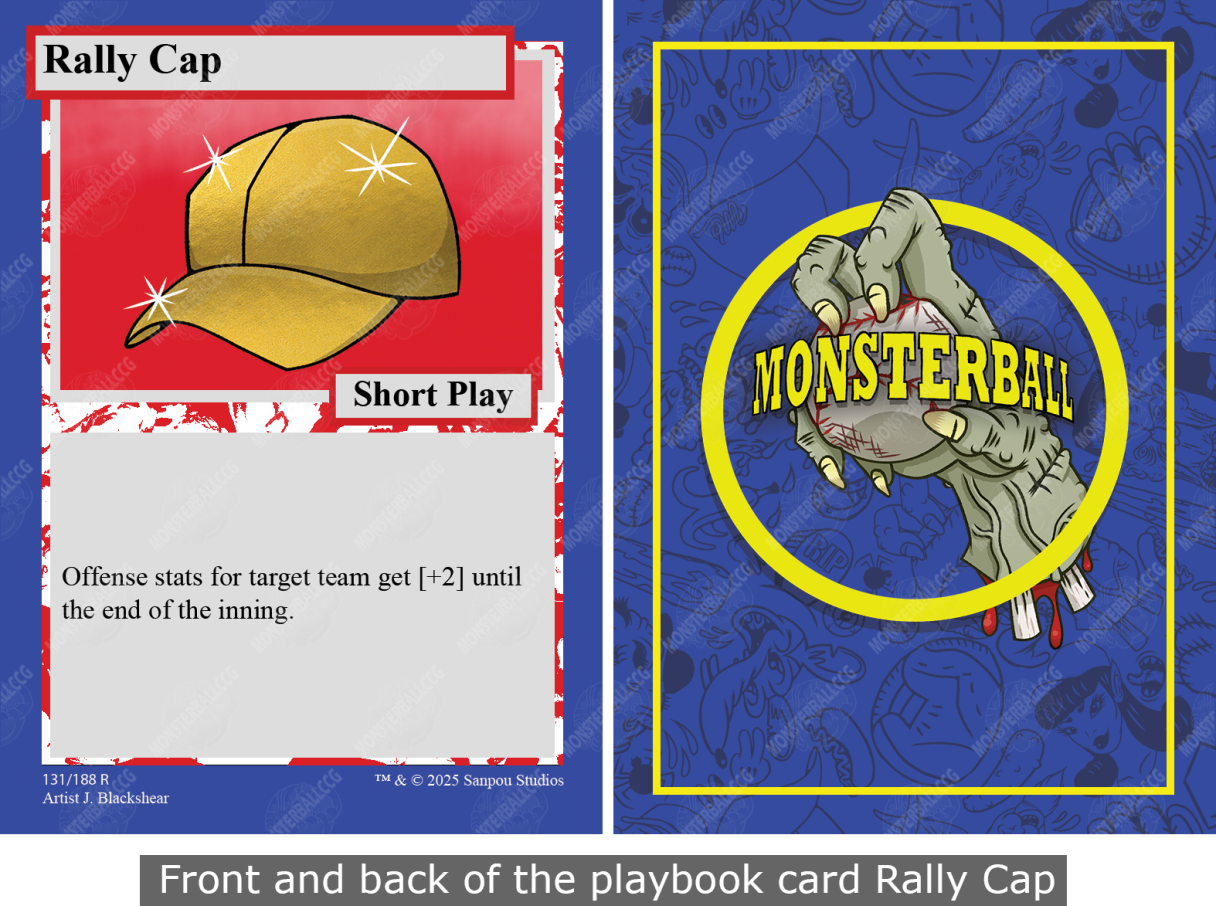
Player Cards
Players make up the offense and defense of your team. The two most common types of player cards are fielders and pitchers.
Player Card Breakdown
The front side of both a fielder’s card and a pitcher’s card list everything you need to know about the player to play a game of monsterball.
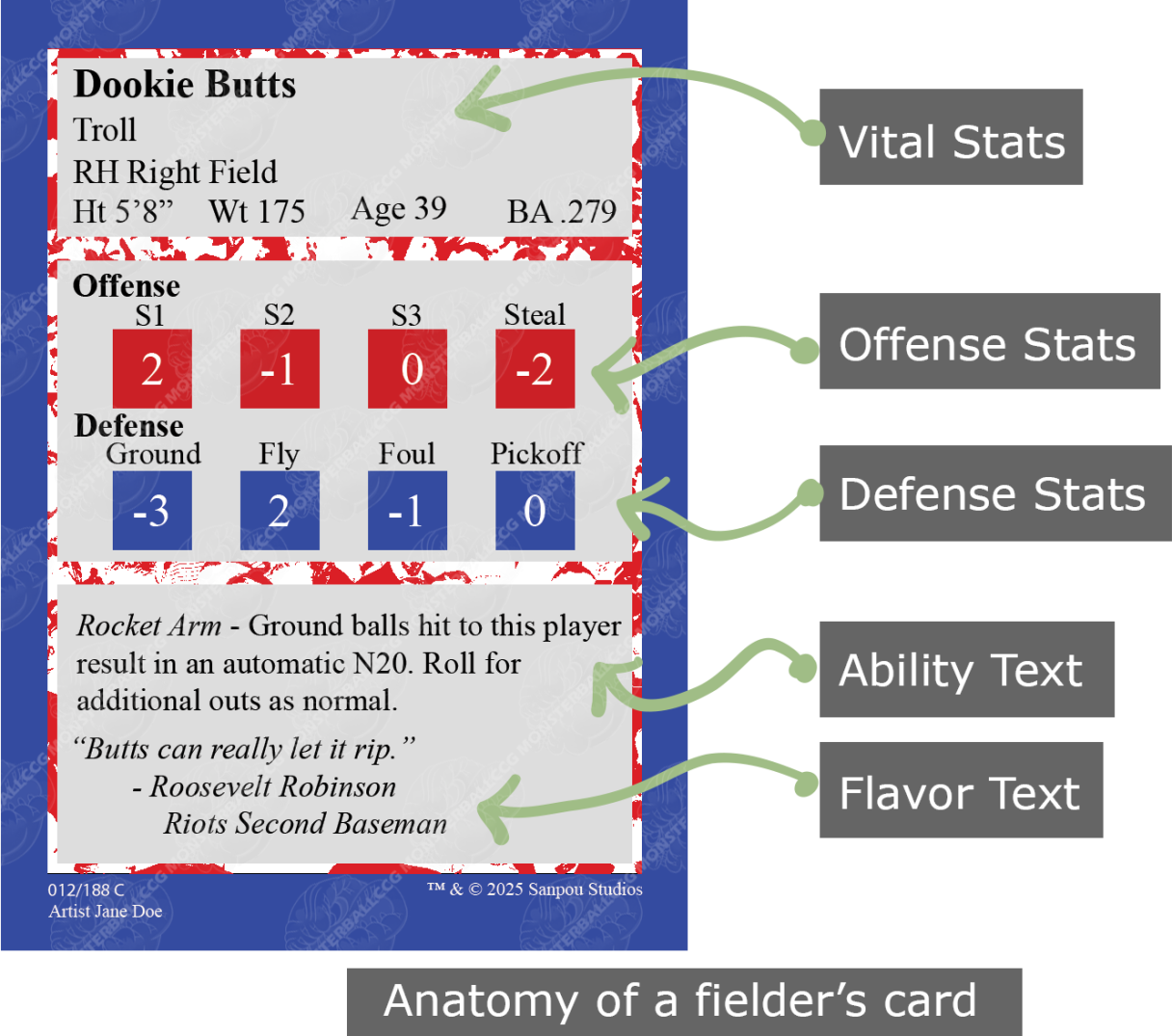
Vital Stats
A fielder’s card and a pitcher’s card will list their name at the very top of the card, followed by their vital stats just below that. These stats tell you the player’s type, their position, if they are right handed, left handed, or a switch hitter, along with their height, weight, age, and batting average.
A player’s name and vital stats give a feel for who the player is and how they might play the game. Not only can vital stats be one of the most entertaining parts of a player’s card, they can also play an important role in how the game plays out!
A player’s type (human, vampire, zombie, robot, etc), height, weight, age, batting average, and left or right handedness can be the target of playbook cards or the abilities of other players. Keen-eyed managers will take note of the name and vital stats of their players and the players on the opposing team - these details can be the difference between victory and defeat!
Offense Stats
Below the vital stats for fielders and pitchers are their offense, defense, or pitching stats. These stats are spread over a 10-point scale ranging from -5 to 5 with -5 being the “lowest” number on the scale and 5 being the “highest” number on the scale.
Below the fielder’s vital stats are their offense stats. Offense stats tell how well a player hits the ball while at bat and how well they steal bases while they’re on base. Each fielder has four offense stats; S1, S2, S3, and Steal. For offense stats, generally the higher the number, the better the stat and the more powerful an offense this fielder has.
Defense Stats
Below the fielder’s offense stats are their defense stats. Defense stats tell you how well a fielder can field a ball if it is hit to them. Each fielder has four defense stats; Ground, Fly, Foul, and Pickoff. As with offense stats, a higher number in each stat generally means the player is a better defensive player. The higher these stats are, the better the player is at fielding.
Pitcher cards have a different set of stats than fielder cards. Instead of offense and defense stats, you'll find pitching stats and a pitching stamina grid.
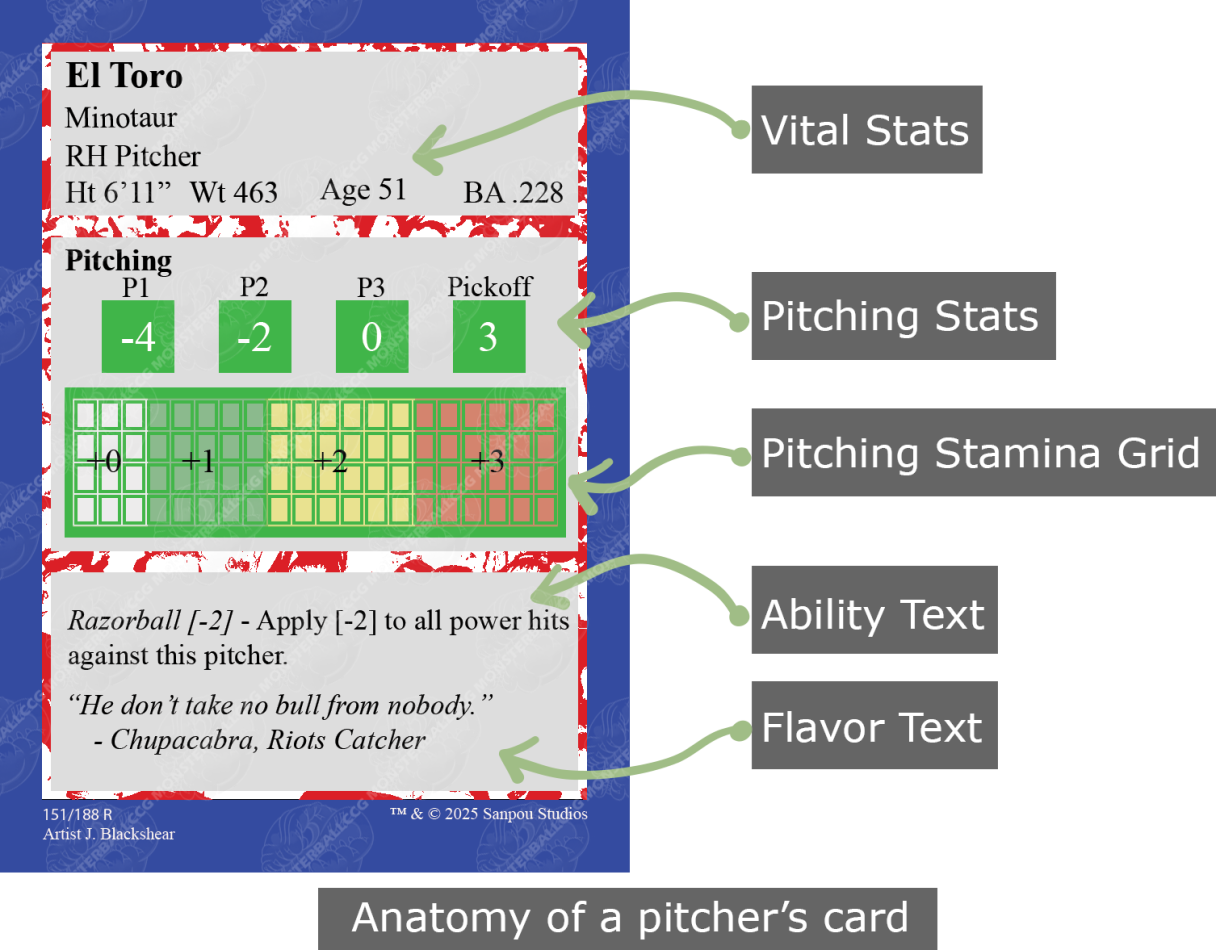
Pitching Stats
A pitcher’s card will look very similar to a fielder’s card except that below the pitcher’s vital stats, the pitcher’s pitching stats will be listed instead. Pitching stats tell you how well a pitcher can throw a ball. Each pitcher has four pitching stats; P1, P2, P3, and Pickoff. Pitching stats work in the OPPOSITE way that offense and defense stats work. In most cases, a lower pitching stat indicates a better pitcher. Pickoff stats work exactly the same way for both fielders and pitchers. For pitchers, lower P1, P2, and P3 numbers indicate better pitching skill, while a higher pick-off stat indicates a better pick-off ability.
Pitching Stamina Grid
Below the pitcher’s pitching stats is the pitcher’s pitching stamina grid. The pitching stamina grid both tracks how many pitches a pitcher has thrown and also impacts how well a pitcher pitches as a game moves through the innings. The pitching stamina grid is filled from left to right. As the grid fills, the indicated modifier for each grid section is applied to the pitcher’s pitching stats. For example, in the +0 section of a pitching stamina grid, [+0] is added to the pitcher’s P1, P2, and P3. Likewise, in the +2 section of a pitching stamina grid, [+2] is added to the pitcher’s P1, P2, and P3. Different pitchers can have wildly different pitching stamina grids - keep this in mind while choosing your pitchers!
Abilities and Flavor Text
Below a fielder’s defense stats and below a pitcher’s pitching stamina grid are their abilities, if they have any. Some abilities are common and may be indicated by keywords such as Didn’t Go, Undying, or Boogerball. Other abilities may be unique to that player and are spelled out in the player’s abilities section.
Flavor Text
Finally, below a player’s abilities you might find flavor text for the card, which may include quotes from or interesting information about the player. Flavor text almost never has an impact on the game, but it can be fun to read.
Playbook Cards
Playbook cards are used to influence the game and come in three main flavors: long plays, short plays, and quick plays.
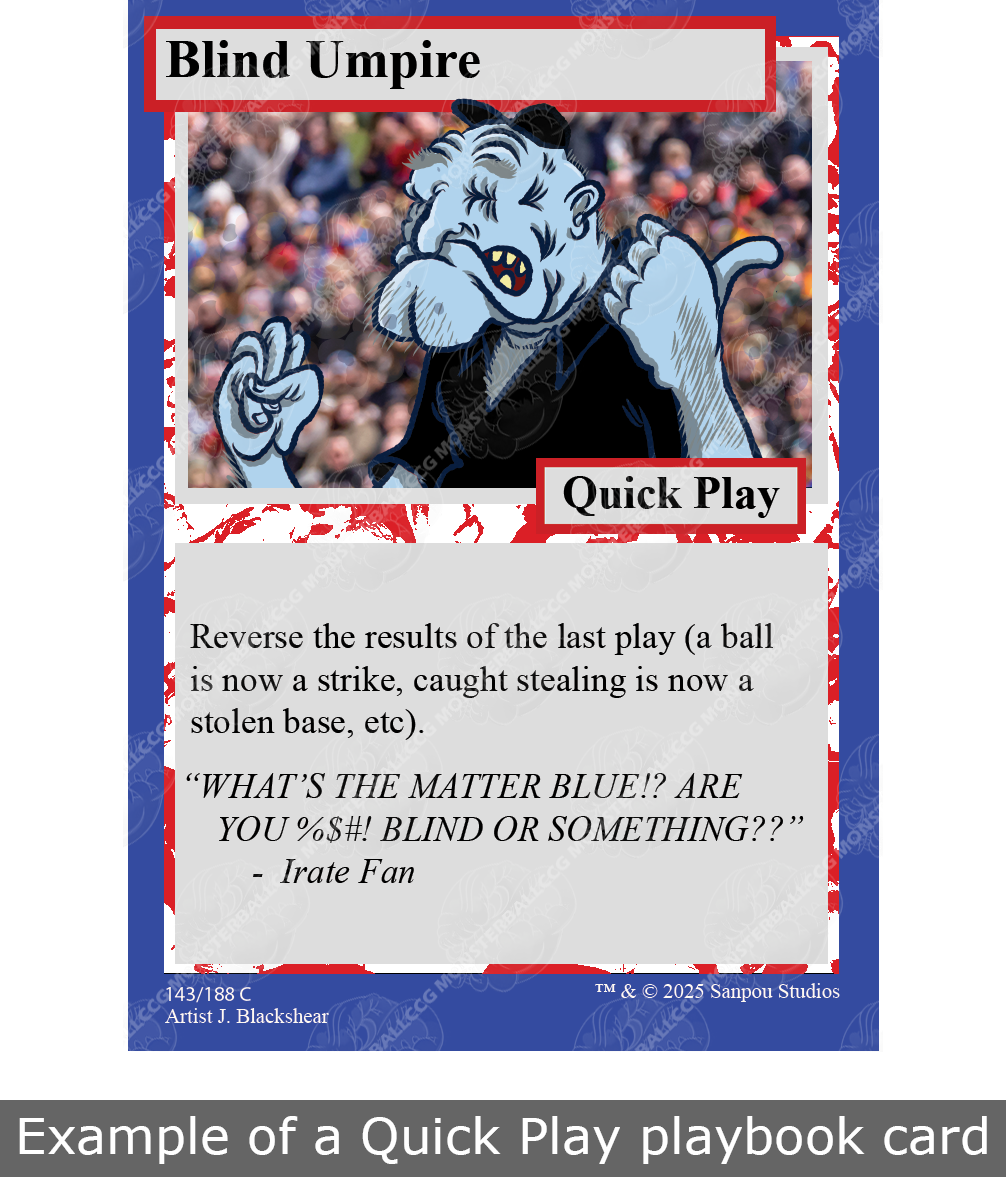
Long play cards stay active from the moment they are played until the game ends or until they are removed from play - whichever comes first.
Short play cards last from the moment they are played until the end of the inning. No matter if a short play card is played at the top of the inning before the first pitch of the inning is thrown, or at the bottom of the inning, right before the last out is made, once the inning is over, the short play card is removed from play and put into its manager’s graveyard.
Quick play cards only stay in play until their effects are resolved. After this, the quick play card is removed from play and placed into its manager’s graveyard.
Some playbook cards can be played at any time a manager chooses while other playbook cards can only be played in response to some event that took place in the game. Read each playbook card carefully to know when and how it can be played.
Building a Team
Now that you are familiar with the types of cards you’ll use during a monsterball game, it’s time to put together a team! If you are new to Monsterball, the quickest and easiest way to build a team is with a pre-made monsterball team deck that includes all of the players and playbook cards that you will need to start playing right away.
For more advanced managers, putting together a custom team of monsters is an exciting undertaking. With an ever-expanding universe of monsters and playbook cards, creating a custom team provides endless opportunities to build a team that plays to match your management style.
A team consists of 26 players: 1 catcher, 4 infielders, 3 outfielders, 1 starting pitcher, one designated hitter, and then any mix of pitchers and fielders that you choose until you reach 26 total players.
Playing the Game
You’ve learned about the cards, you've got your team together, now it’s time to play a game!
Game Setup
There are a few things that need to happen before the game starts. First, both managers need to agree on which team will be the “home” team and which team will be the “away” team. You can choose which team is home and which is away any way you’d like, but if you get stuck, we recommend rolling dice or throwing best 3 of 5. In monsterball, the away team bats first, at the “top” of the inning, and the home team bats last, at the “bottom” of the inning.
The next order of business is to set up the playing field. A monsterball field consists of 4 bases arranged in a diamond pattern with a pitcher’s area in the center. You can choose to use official Monsterball bases, scraps of paper, or even coins. Anything will work for bases!
Next, both managers need to build a 9-monster starting lineup from their 26-monster team roster. This will include 1 monster to play each position; first base, second base, third base, short stop, left field, center field, right field, pitcher, catcher, and designated hitter (to take the pitcher’s place when it’s time to go on the offensive).
In addition to choosing which monster will play each fielding position both managers must decide the order in which their players will bat. Premade decks come with a batting lineup card that you can fill out so you don’t forget your lineup, but a note card or a scrap of paper will work just as well. Once both managers have made their fielding and lineup choices and inspected and approved the other manager’s choices, it’s time to play some monsterball!.
Innings
Each game of monsterball is divided into 5 innings. During the first half of each inning, also called the “top” of the inning, the away team plays offense (they bat), and the home team plays defense (they take the field and pitch). During the second half of the inning, also called the “bottom” of the inning, the home team plays offense and the away team plays defense. To help keep track of the innings (and just about everything else), premade monsterball team decks come with a scoreboard card that you can use to tally the score, the innings, balls, strikes, and outs - but a notecard or piece of paper will work just as well.
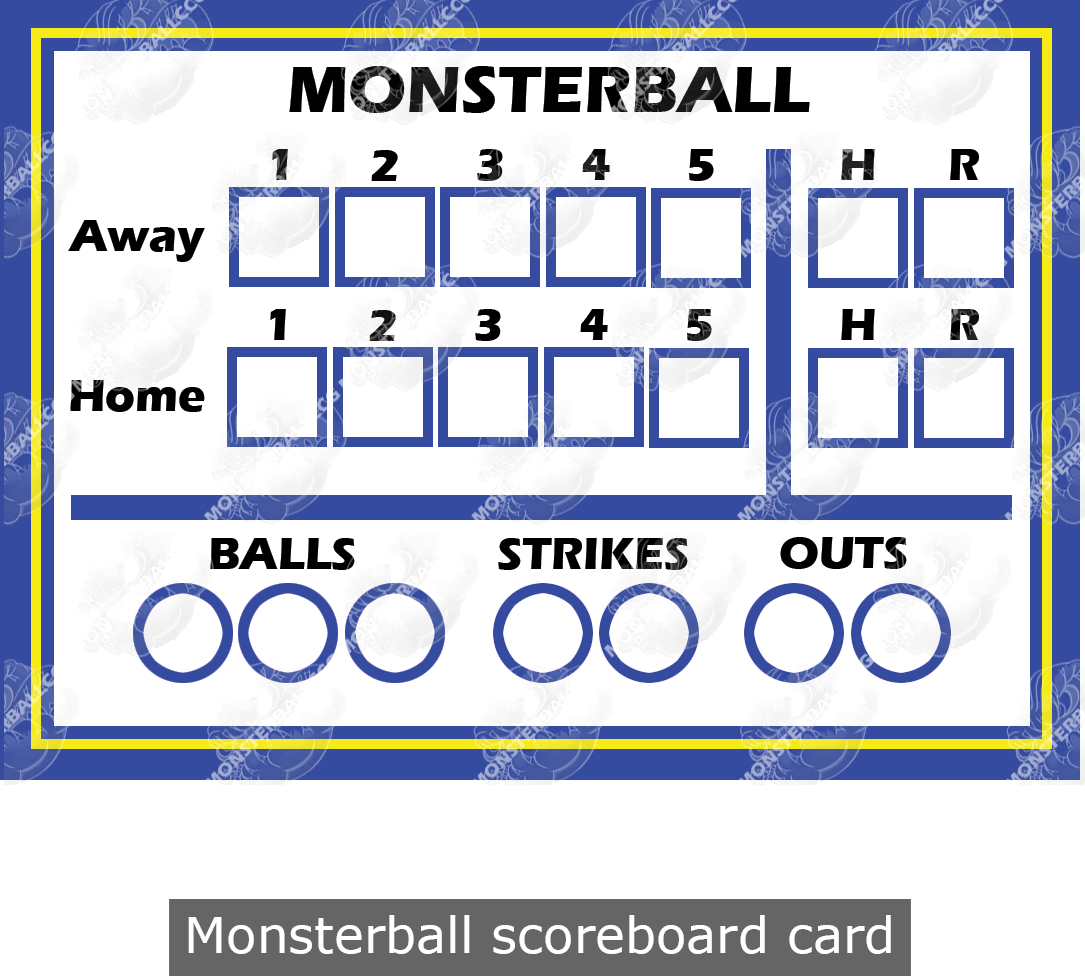
Building a Team
Now that you are familiar with the types of cards you’ll use during a monsterball game, it’s time to put together a team! If you are new to Monsterball, the quickest and easiest way to build a team is with a pre-made monsterball team deck that includes all of the players and playbook cards that you will need to start playing right away.
The Top of the Inning
At the top of the first inning, both managers draw 4 playbook cards from their playbook deck. These playbook cards can be played at any time during the inning, unless otherwise specified in the playbook card’s text.
At the top of each subsequent inning, both managers draw 2 playbook cards from their playbook deck. Managers only draw 4 playbook cards at the top of the first inning!
Next, the home team manager places their players on the field. There should be a pitcher, a catcher, a first baseman, a second baseman, a short stop, a third baseman, and three outfielders; one in left field, one in center field, and one in right field. Some players have a preference for a certain position and have this position listed on their card. As a manager you can choose to put players in the positions they prefer or you can choose to play them in some other position. It’s your team!
Meanwhile, the visiting team checks their lineup (the order that their players will bat in) and places the next player in that order at home plate. Now that the field is set, the inning can begin.
Throwing Fingers
Battles between pitchers and batters are decided by both managers throwing fingers - this is one of the most important parts of monsterball and your time to shine as a manager! Throwing or throwing fingers works like this: both managers hold up a fist. They count 1 - 2 - 3 - THROW! and then show either 1, 2, or 3 fingers.
The number of fingers each manager shows corresponds with the pitching and offense numbers on the player cards of the respective pitcher and batter that are on the field. For example, if the manager of the pitcher throws a 1, that corresponds with P1. If the manager of the batter throws a 3, that corresponds with S3.
After throwing, the managers compare fingers to determine who wins that pitch and to determine what happens next. In Monsterball, 3 fingers wins over 2 fingers. 2 fingers wins over 1 finger. 1 finger wins over 3 fingers. For each batter, the managers continue throwing until either the batter gets 3 strikes (they’re out!), the batter gets 4 balls (free base!), or the batter gets a hit (now things get really exciting!)

Don’t forget to mark off a box on the current pitcher’s pitching stamina grid after each throw, no matter the outcome!
If you are playing a playbook card in lew of throwing (some cards specify this in their text), throw no fingers (a closed fist) to indicate that you are playing a playbook card. This throw still counts on the pitcher’s pitching stamina grid unless otherwise noted on the playbook card being played.
Now let’s look at what happens when the managers throw.
Pitcher Wins the Throw
If the pitcher wins the throw, the pitch was a strike. Mark a strike on your scoreboard card! When a pitcher gets 3 strikes against a batter, the batter is out! Mark an out on your score card and bring the next batter in the lineup to bat.
The Throw is a Tie
If the throw was a tie, both managers throw again (do not mark this next throw on the pitcher’s pitching stamina grid). If the pitcher wins the second throw, the pitch is a foul ball and counts as a strike! Mark a strike on your scoreboard card - but keep in mind that a batter can only get 2 strikes from fouls - any fouls a batter racks up after the first 2 strikes (no matter how the strike was made) don’t count!
If the batter wins the second throw, the pitch counts as a ball. Mark a ball on your scoreboard card. If the pitcher throws 4 balls against a batter, the batter gets a walk - meaning they advance to first base without having to hit the ball. If there is already a base runner on first, that runner moves to second, if there is a runner on second that runner moves to third, and so on.
If the second throw was another tie, managers throw again! The same rules apply as above; if the batter wins the third throw, the pitch counts as a ball, if the pitcher wins the third throw, the pitch counts as a ball. But if the THIRD throw in a row is a tie, the batter was hit by the pitch! Immediately move that batter to first base. If there is already a base runner on first, that runner moves to second, if there is a runner on second that runner moves to third, and so on.
Beware! When a pitcher hits 4 batters in a game, the benches will clear in an all-out monster brawl and that pitcher is removed from the game.
Batter Wins the Throw
If the batter wins a throw, the batter hit the ball! Take note of what the managers threw - this will be important. To determine what kind of hit the batter got, the batter rolls d20. This is the unmodified hit roll. Add this roll to the stat of the pitch that the pitcher threw and to the stat of the swing that the batter threw. This is the modified hit roll. Find this number on the Batting Quick Reference - premade monsterball team decks come with this card, but you can find a batting quick reference below.
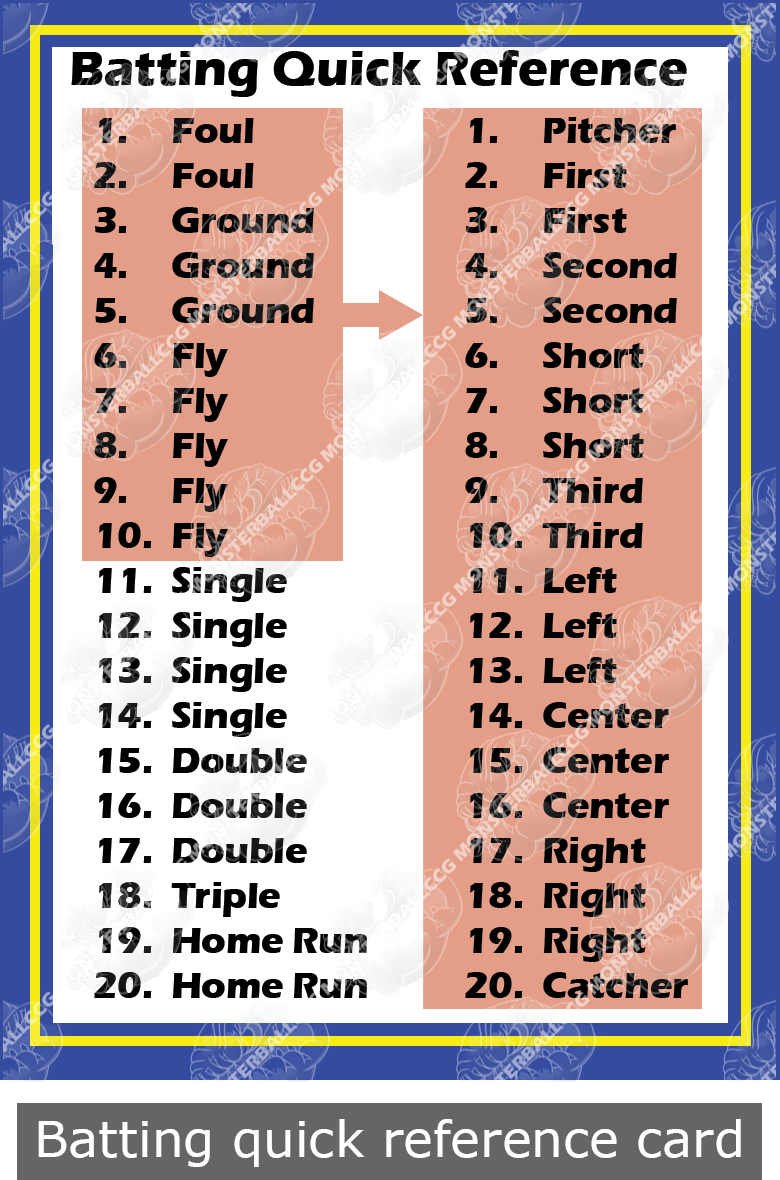
In the example above, Jerek Yeeter got a hit off Artemis Schimmelpfennig by throwing a 1 which beats Schimmelpfinnig's 3. Yeeter's unmodified roll is a 10. Yeeter's S1 stat is +3, Schimmelpfennig's P3 stat is -1; 10 + 3 - 1 = 12. Yeeter checks the Batting Quick Reference card for a 12... and it's a single!
Nat 20 Home Run
Let’s start with the best case scenario first. If the batter rolls a natural 20 (meaning their unmodified hit roll is 20), this counts as an automatic homerun. The batter makes their way around the bases and scores one run for themselves and for all other base runners that were already on base.

Contact Hit
If the modified hit roll was between 1 and 10, the batter got a contact hit! The batter rolls d20 again and consults the Batter Quick Reference to determine where the ball was hit. If the ball was hit to a spot where a fielder is currently playing, then bother managers roll d20. The defense’s manager adds the fielder’s defense stat that corresponds to the contact type (foul, ground, or fly) to their fielder’s roll - this is the fielder’s modified defense roll. If the fielder’s modified defense roll is equal to or greater than the batter’s roll, the batter is out! Mark an out on your score card and bring the next batter in the lineup to bat.
If the batter’s roll is greater, the batter moves to first base. If there is already a base runner on first, that runner moves to second, if there is a runner on second that runner moves to third, and so on.
Negative Modified Contact Roll
If the batter’s modified hit roll is zero or less, the pitch counts as a strike. Mark a strike on your score card. If this is the third strike, the batter is out! Mark an out on your score card and bring the next batter in the lineup to bat.
Empty Fielding Positions
If a contact hit ends up going to a position where there is currently no fielder, the hit counts as a single. If there is already a base runner on first, that runner moves to second, if there is a runner on second that runner moves to third, and so on.
Nat 20 Double Play
If a fielder rolls a natural 20 against a hit (meaning their unmodified defense roll is 20), this results in an automatic out. If there is a player on first base when the fielder rolls a nat 20, that player is also out and this counts as a force-out double play. If there are players on first base and second base when the fielder rolls a nat 20, the fielder may roll again. If the fielder rolls another nat 20, all three base runners are out and this counts as a force-out triple play. Finally, if the fielder rolls a nat 20 and there are base runners but no force outs (meaning there is a runner on second and or third but no runner on first), the fielder chooses which base runner to get out in addition to the batter being out.
Foul Ball
Note that foul balls that come from a contact hit can result in an out (if the fielder’s modified roll is higher than the batter’s roll), but a batter can not get on base by hitting a foul. Also note that only foul balls that come from contact hits can result in an out. Foul balls that come from a tie-breaker throw are not in play and can not result in an out.
Pitchers Fielding
All pitchers have defense stats of 0 for ground, fly, and foul balls unless otherwise noted on their cards.
Power Hit
If the modified hit roll was between 11 and 20, the batter got a power hit! If the hit was a single, the batter goes to first base and all other base runners advance 1 base. If the hit was a double, the batter goes to second base and all other base runners advance 2 bases. If the hit was a triple, the batter goes to third base and all other base runners advance 3 bases. If the hit was a homerun, the batter scores a run and all other base runners also score a run.
Stealing
Runners on base can attempt to steal a base at any time. When a runner successfully steals a base, they move to the next base. When a runner unsuccessfully steals a base, they are out! A runner can steal any base, including home!
When a runner attempts to steal before a pitch is thrown, the runner will be challenging the pitcher’s pickoff. When a runner attempts to steal a base after a pitch was thrown, the runner will be challenging the catcher's pickoff.
When a runner attempts to steal a base, both managers roll d20. The base runner adds their Steal modifier to their roll and either the pitcher (pre-pitch) or catcher (post-pitch) add their Pickoff modifier to their roll. If the base runner’s modified roll is the greater number, they steal the base successfully. If the pitcher or catcher’s modified roll is higher, the runner was caught stealing and is out - mark an out on the scorecard.
If the modified rolls are a tie, the base runner is in a pickle! To resolve the pickle, both players throw fingers and the winner of two out of three of those matches wins. If the base runner wins, they steal successfully. If the defender wins, the base runner is out, mark an out on your scorecard!
If the baserunner is attempting to steal home, the pitcher gets an automatic [+4] to their pickoff modifier and the catcher gets an automatic [+5] to their pickoff modifier.
Emptying the Benches
When a pitcher hits 4 batters, both teams go wild and the benches empty. To quell the chaos, each manager chooses a single player on their team. These players will duke it out, throwing for the best of 5, with the losing player being sent to their manager’s graveyard. In the event of a tie throw, compare the offense stat thrown for the player currently on offense to the defense stat thrown for the player currently on defense - the greater number wins that throw.
Once the ruckus settles down, all fielders still in the game return to their positions, all batters still in the game return to their lineup positions, the defense fields a new pitcher, and the game continues.
Untimely Demise
If a player that is currently on offense is put into a graveyard from play or is removed from the game from play, this counts as an out. Yes, you can kill your way to 3 outs!
Substitutions
You may substitute a player on your bench for a player on the field or batting lineup at any point during the game.A player that is making a substitution assumes that substituted player’s roles in for the rest of the game or until they leave play.
When changing pitchers, keep in mind that a pitcher must have pitched against at least 3 batters before a new pitcher comes into the game to replace them. If a pitcher is sent to a graveyard or removed from the game, this rule does not apply.
Finally, once a player has been replaced, they are removed from the game and can not come back into the game.
Fielders Pitching
All fielders have pitching stats P1, P2, and P3 of -3 unless otherwise noted on their cards.
Bottom of the Inning
Once the home team accumulates 3 outs against the away team, the teams switch spots with the away team taking the field and the home team coming up to bat. Remember that both managers must keep their batting lineup in order and may only field the players that were agreed upon before the game, with the exception of any substitutions that have been made along the way.
Ending the Inning
Once the bottom of the inning is over, both managers discard their hands down to 4 playbook cards. All short play playbook cards are put in their manager’s graveyards. The team with the highest number of runs scored during the inning wins the inning and gets 1 point for the inning. If both teams have the same number of runs, the inning is considered a tie and both teams get 1 point for the inning.
Ending the Game
At the end of the 5th inning the team with the highest number of points (aka innings won), wins the game! If there is a tie at the end of the 5th inning for total innings won, the game must go on! Keep playing until an inning ends with one team in the lead.